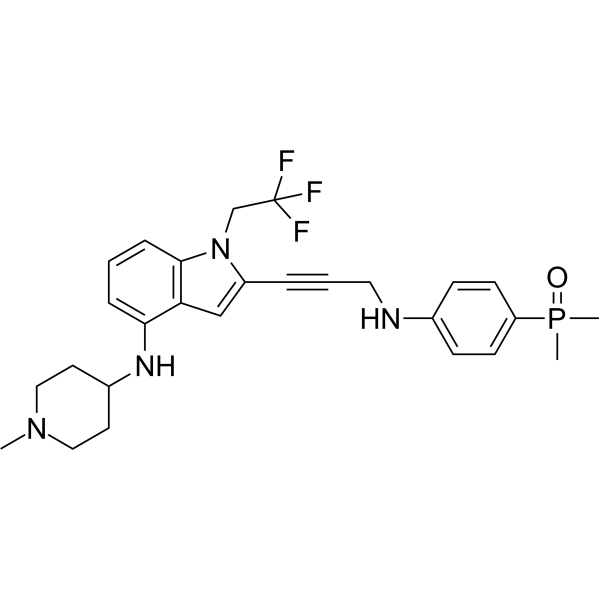Physicochemical Properties
| Molecular Formula | C27H32F3N4OP |
| Molecular Weight | 516.538157463074 |
| Exact Mass | 516.226 |
| CAS # | 2849340-59-4 |
| PubChem CID | 166176923 |
| Appearance | Light yellow to orange solid powder |
| LogP | 4.5 |
| Hydrogen Bond Donor Count | 2 |
| Hydrogen Bond Acceptor Count | 7 |
| Rotatable Bond Count | 7 |
| Heavy Atom Count | 36 |
| Complexity | 833 |
| Defined Atom Stereocenter Count | 0 |
| SMILES | N1(CC(F)(F)F)C2=C(C(NC3CCN(C)CC3)=CC=C2)C=C1C#CCNC1=CC=C(P(C)(C)=O)C=C1 |
| InChi Key | TWHPNHHZQSJOEI-UHFFFAOYSA-N |
| InChi Code | InChI=1S/C27H32F3N4OP/c1-33-16-13-21(14-17-33)32-25-7-4-8-26-24(25)18-22(34(26)19-27(28,29)30)6-5-15-31-20-9-11-23(12-10-20)36(2,3)35/h4,7-12,18,21,31-32H,13-17,19H2,1-3H3 |
| Chemical Name | 2-[3-(4-dimethylphosphorylanilino)prop-1-ynyl]-N-(1-methylpiperidin-4-yl)-1-(2,2,2-trifluoroethyl)indol-4-amine |
| HS Tariff Code | 2934.99.9001 |
| Storage |
Powder-20°C 3 years 4°C 2 years In solvent -80°C 6 months -20°C 1 month Note: Please store this product in a sealed and protected environment (e.g. under nitrogen), avoid exposure to moisture and light. |
| Shipping Condition | Room temperature (This product is stable at ambient temperature for a few days during ordinary shipping and time spent in Customs) |
Biological Activity
| Targets | EC50: 104 nM (p53 mutation Y220C)[1] |
| ln Vitro | The p53 protein, also known as the "guardian of the human genome," is a tetrameric transcription factor that controls the expression of a subset of target genes to stop genome alteration. Each p53 monomer has 393 amino acids and is separated into five major regulatory domains, which are the transactivation domain (TAD), proline-rich region (PR), DNA binding domain (DBD), oligomerization domain (OD), and C-terminus[1]. Additionally, each p53 homotetramer is biologically active as a homotetramer. |
| References |
[1]. Compounds targeting y220c mutant of p53. WO2022213975A1. |
Solubility Data
| Solubility (In Vitro) | DMSO : 100 mg/mL (193.60 mM) |
| Solubility (In Vivo) |
Solubility in Formulation 1: ≥ 2.5 mg/mL (4.84 mM) (saturation unknown) in 10% DMSO + 40% PEG300 + 5% Tween80 + 45% Saline (add these co-solvents sequentially from left to right, and one by one), clear solution. For example, if 1 mL of working solution is to be prepared, you can add 100 μL of 25.0 mg/mL clear DMSO stock solution to 400 μL PEG300 and mix evenly; then add 50 μL Tween-80 to the above solution and mix evenly; then add 450 μL normal saline to adjust the volume to 1 mL. Preparation of saline: Dissolve 0.9 g of sodium chloride in 100 mL ddH₂ O to obtain a clear solution. Solubility in Formulation 2: ≥ 2.5 mg/mL (4.84 mM) (saturation unknown) in 10% DMSO + 90% (20% SBE-β-CD in Saline) (add these co-solvents sequentially from left to right, and one by one), clear solution. For example, if 1 mL of working solution is to be prepared, you can add 100 μL of 25.0 mg/mL clear DMSO stock solution to 900 μL of 20% SBE-β-CD physiological saline solution and mix evenly. Preparation of 20% SBE-β-CD in Saline (4°C,1 week): Dissolve 2 g SBE-β-CD in 10 mL saline to obtain a clear solution. (Please use freshly prepared in vivo formulations for optimal results.) |
| Preparing Stock Solutions | 1 mg | 5 mg | 10 mg | |
| 1 mM | 1.9360 mL | 9.6798 mL | 19.3596 mL | |
| 5 mM | 0.3872 mL | 1.9360 mL | 3.8719 mL | |
| 10 mM | 0.1936 mL | 0.9680 mL | 1.9360 mL |
